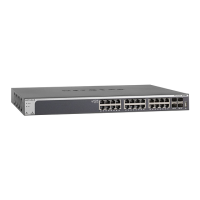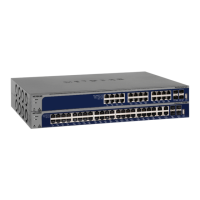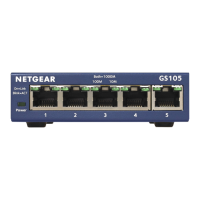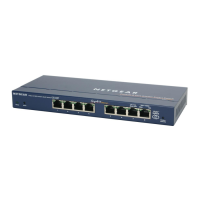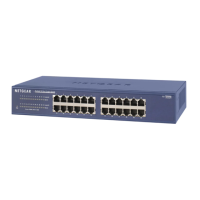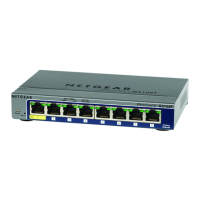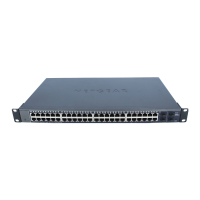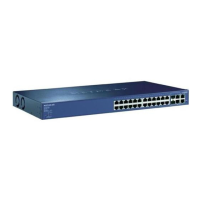Do you have a question about the NETGEAR XS728T ProSAFE and is the answer not in the manual?
Explains how to manage and monitor the switch using a web browser and the management interface.
Details how to connect the switch to the network for remote management via browser or SNMP.
Guides on finding the switch's IP address in a network with a DHCP server using SCC.
Explains how to assign a static IP to the switch using SCC in networks without DHCP.
Instructions for setting up the administrative system's IP to match the switch's subnet.
Steps to access the switch's management interface via a web browser.
Describes how physical and logical interfaces on the switch are identified and named.
Configures basic switch information, including management interface IP, CPU status, and system settings.
Provides a Java applet to view switch ports and navigate configuration options.
Explains configuration for Simple Network Management Protocol (SNMP) v1/v2 and v3.
Details Link Layer Discovery Protocol (LLDP) and LLDP-MED configuration for network topology discovery.
Configures DHCP snooping for network security by filtering untrusted DHCP messages.
Views and monitors physical port information and configures global and port-specific settings.
Configures Link Aggregation Groups (LAGs) to combine links for increased fault tolerance and load sharing.
Defines Virtual Local Area Networks (VLANs) to segment the network and improve management.
Configures Voice VLAN settings to prioritize voice traffic and ensure quality for IP phones.
Prioritizes time-sensitive voice traffic over data traffic for VoIP protocols.
Provides a tree topology to prevent network loops and ensure a single path between end stations.
Manages multicast traffic forwarding and IGMP/MLD snooping for efficient network resource usage.
Displays unicast entries for forwarding and filtering information, used for transparent bridging.
Configures IP routing parameters, including mode and MTU settings for packet forwarding.
Enables and configures VLAN routing interfaces, assigning IP addresses and subnet masks.
Configures static and default routes, and views learned routes for network traffic management.
Manages Address Resolution Protocol (ARP) for mapping Layer 2 MAC addresses to Layer 3 IPv4 addresses.
Configures IPv6 routing parameters, including global settings, addresses, and prefix information.
Configures Class of Service (CoS) queueing to prioritize network traffic based on defined criteria.
Classifies traffic into streams and applies QoS treatment based on per-hop behaviors.
Configures login password, RADIUS, TACACS+, and authentication lists for secure management access.
Configures HTTP and HTTPS access, access control profiles, and rules for management interface security.
Configures 802.1x port-based authentication and guest VLAN access for network security.
Configures MAC filters, storm control, port security, and private VLANs for network traffic management.
Configures Access Control Lists (ACLs) for IPv4, IPv6, and MAC addresses to filter traffic.
Views traffic statistics, port status, EAP statistics, and cable test results for switch interfaces.
Manages system messages for faults, errors, and configuration changes, stored locally or forwarded.
Configures port mirroring to analyze network traffic by copying traffic to a destination port.
Displays system resource utilization, including TCAM entries used by features like ACLs and DiffServ.
Provides options to reboot the switch or reset system configuration to factory default values.
Manages system file uploads (archive, text config, logs) to remote systems via TFTP, HTTP, or USB.
Downloads system files (archive, text config) from remote systems to the switch via TFTP, HTTP, or USB.
Manages switch software images, including dual image configuration and status for upgrading/downgrading.
Provides utilities like Ping, Traceroute, and Tech Support Info for diagnosing network issues.
Provides links to NETGEAR support site and user guides for online assistance and product information.
Connects to the NETGEAR support website for product information and assistance.
Provides access to the complete user guide available online on the NETGEAR website.
Guides on registering the switch online to confirm email, improve support, and provide feedback.
Lists supported features and their default configurations for the switch.
Demonstrates configuration scenarios for VLANs, including tagged and untagged traffic.
Provides examples for configuring MAC, IPv4, and IPv6 ACLs for traffic filtering and security.
Illustrates DiffServ configuration using classes, policies, and services for QoS.
Demonstrates configuring 802.1x-based authentication, guest VLAN, and RADIUS integration.
Shows how to create MSTP instances and configure Spanning Tree Protocol settings for network loop prevention.
Explains setting up inter-VLAN routing using static routes and IP configuration.
Explains how to manage and monitor the switch using a web browser and the management interface.
Details how to connect the switch to the network for remote management via browser or SNMP.
Guides on finding the switch's IP address in a network with a DHCP server using SCC.
Explains how to assign a static IP to the switch using SCC in networks without DHCP.
Instructions for setting up the administrative system's IP to match the switch's subnet.
Steps to access the switch's management interface via a web browser.
Describes how physical and logical interfaces on the switch are identified and named.
Configures basic switch information, including management interface IP, CPU status, and system settings.
Provides a Java applet to view switch ports and navigate configuration options.
Explains configuration for Simple Network Management Protocol (SNMP) v1/v2 and v3.
Details Link Layer Discovery Protocol (LLDP) and LLDP-MED configuration for network topology discovery.
Configures DHCP snooping for network security by filtering untrusted DHCP messages.
Views and monitors physical port information and configures global and port-specific settings.
Configures Link Aggregation Groups (LAGs) to combine links for increased fault tolerance and load sharing.
Defines Virtual Local Area Networks (VLANs) to segment the network and improve management.
Configures Voice VLAN settings to prioritize voice traffic and ensure quality for IP phones.
Prioritizes time-sensitive voice traffic over data traffic for VoIP protocols.
Provides a tree topology to prevent network loops and ensure a single path between end stations.
Manages multicast traffic forwarding and IGMP/MLD snooping for efficient network resource usage.
Displays unicast entries for forwarding and filtering information, used for transparent bridging.
Configures IP routing parameters, including mode and MTU settings for packet forwarding.
Enables and configures VLAN routing interfaces, assigning IP addresses and subnet masks.
Configures static and default routes, and views learned routes for network traffic management.
Manages Address Resolution Protocol (ARP) for mapping Layer 2 MAC addresses to Layer 3 IPv4 addresses.
Configures IPv6 routing parameters, including global settings, addresses, and prefix information.
Configures Class of Service (CoS) queueing to prioritize network traffic based on defined criteria.
Classifies traffic into streams and applies QoS treatment based on per-hop behaviors.
Configures login password, RADIUS, TACACS+, and authentication lists for secure management access.
Configures HTTP and HTTPS access, access control profiles, and rules for management interface security.
Configures 802.1x port-based authentication and guest VLAN access for network security.
Configures MAC filters, storm control, port security, and private VLANs for network traffic management.
Configures Access Control Lists (ACLs) for IPv4, IPv6, and MAC addresses to filter traffic.
Views traffic statistics, port status, EAP statistics, and cable test results for switch interfaces.
Manages system messages for faults, errors, and configuration changes, stored locally or forwarded.
Configures port mirroring to analyze network traffic by copying traffic to a destination port.
Displays system resource utilization, including TCAM entries used by features like ACLs and DiffServ.
Provides options to reboot the switch or reset system configuration to factory default values.
Manages system file uploads (archive, text config, logs) to remote systems via TFTP, HTTP, or USB.
Downloads system files (archive, text config) from remote systems to the switch via TFTP, HTTP, or USB.
Manages switch software images, including dual image configuration and status for upgrading/downgrading.
Provides utilities like Ping, Traceroute, and Tech Support Info for diagnosing network issues.
Provides links to NETGEAR support site and user guides for online assistance and product information.
Connects to the NETGEAR support website for product information and assistance.
Provides access to the complete user guide available online on the NETGEAR website.
Guides on registering the switch online to confirm email, improve support, and provide feedback.
Lists supported features and their default configurations for the switch.
Demonstrates configuration scenarios for VLANs, including tagged and untagged traffic.
Provides examples for configuring MAC, IPv4, and IPv6 ACLs for traffic filtering and security.
Illustrates DiffServ configuration using classes, policies, and services for QoS.
Demonstrates configuring 802.1x-based authentication, guest VLAN, and RADIUS integration.
Shows how to create MSTP instances and configure Spanning Tree Protocol settings for network loop prevention.
Explains setting up inter-VLAN routing using static routes and IP configuration.
| Switching Capacity | 560 Gbps |
|---|---|
| Forwarding Rate | 417 Mpps |
| PoE | No |
| Ports | 24 x 10GBASE-T and 4 x SFP+ |
| Layer | Layer 2, Layer 3 Lite |
| Management | Web-based GUI, SNMP |
| MAC Address Table Size | 32, 000 entries |
| Dimensions | 17.3 x 1.7 in |
| Power Supply | 100-240V AC, 50-60Hz, internal |
| Operating Temperature | 32°F to 104°F (0°C to 40°C) |
| Storage Temperature | -20°C to 70°C (-4°F to 158°F) |
| Humidity | 90% maximum relative humidity, noncondensing |
| Standards Compliance | IEEE 802.3, IEEE 802.3u, IEEE 802.3ab, IEEE 802.3z, IEEE 802.3x, IEEE 802.1Q, IEEE 802.1p, IEEE 802.1w, IEEE 802.1s |
| Power Consumption | 120W (maximum) |
